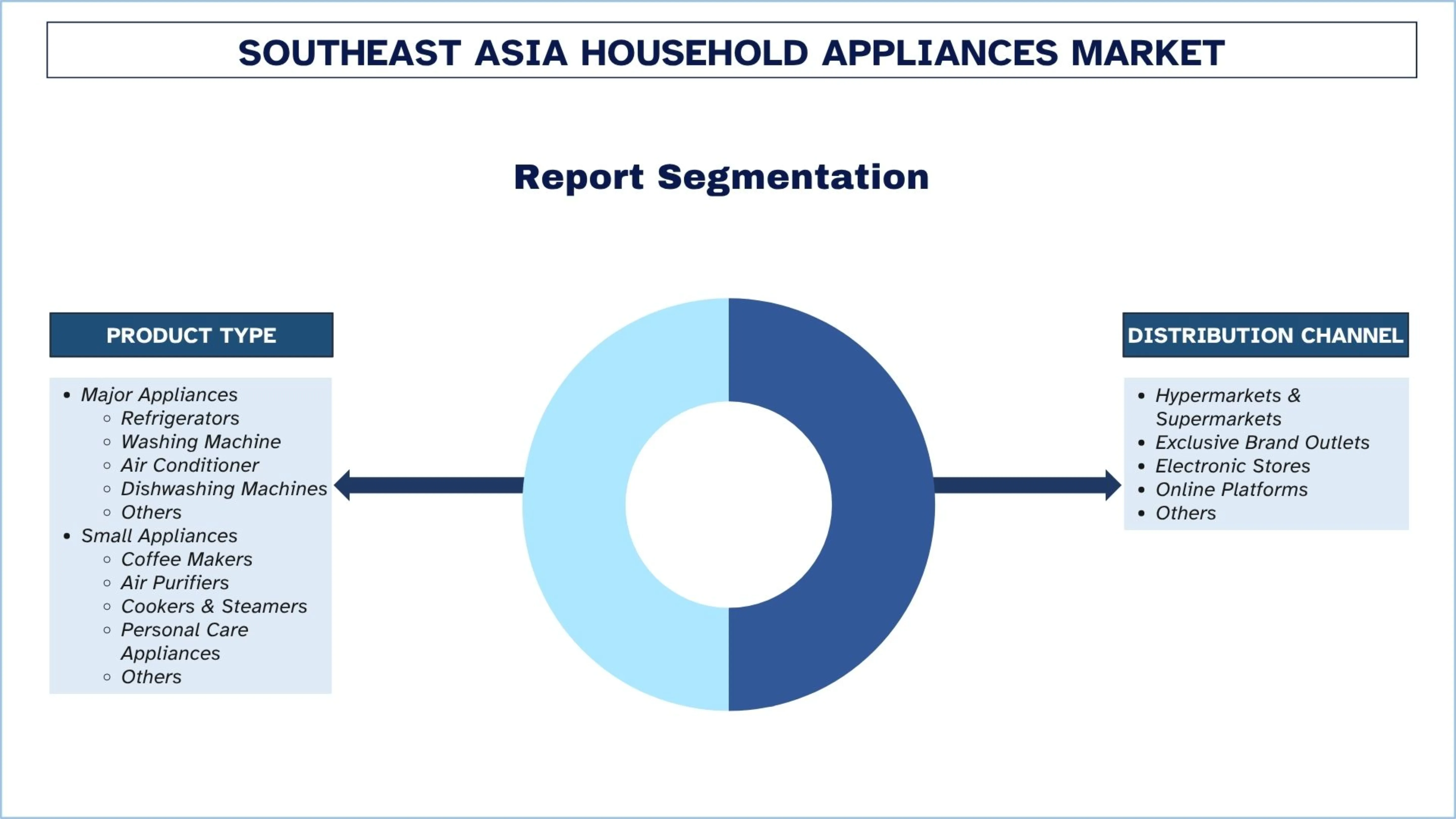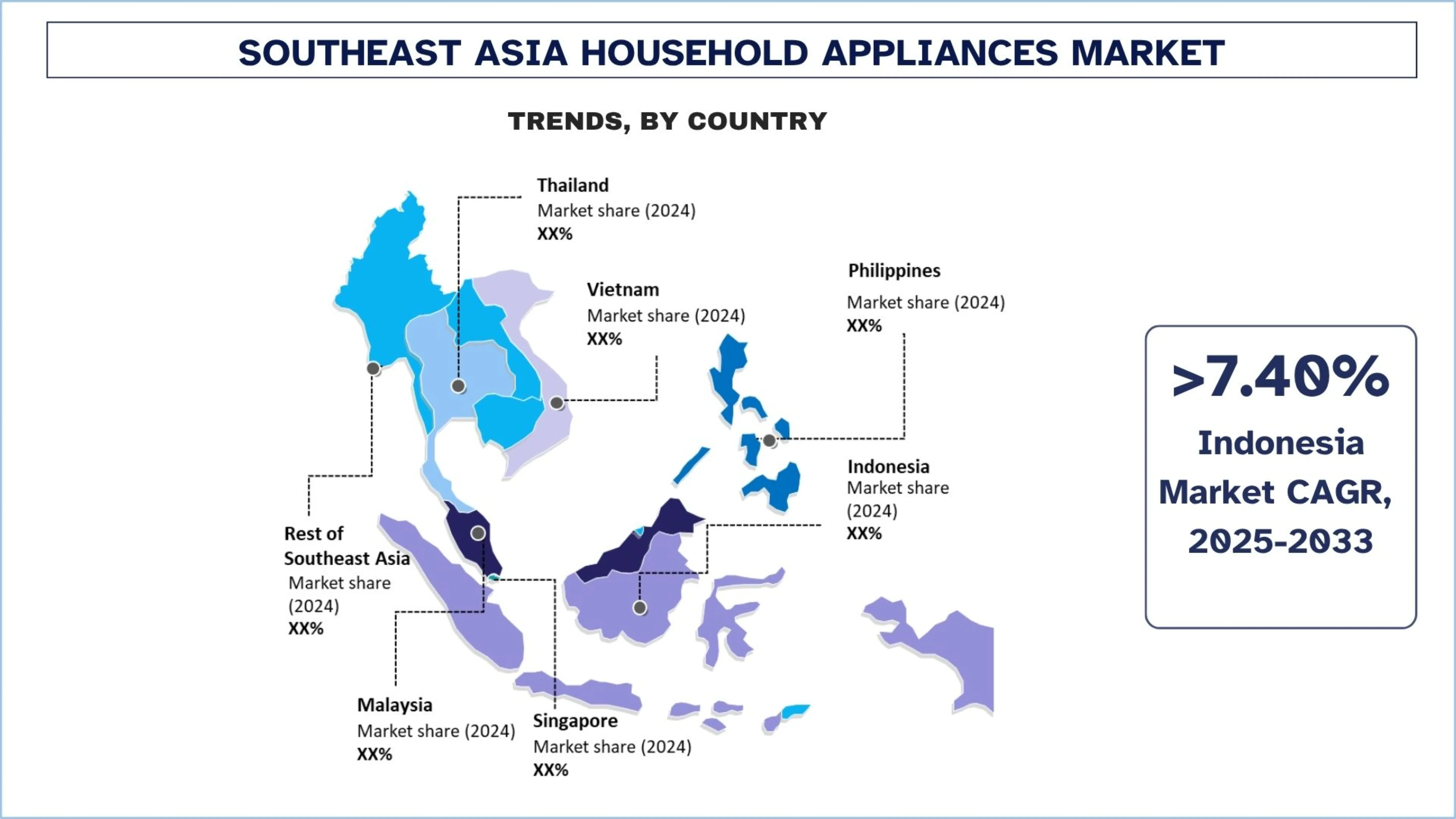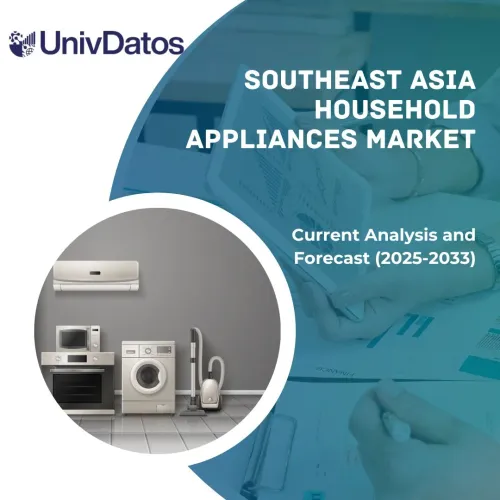- Home
- About Us
- Industry
- Services
- Reading
- Contact Us
Southeast Asia Household Appliances Market: Current Analysis and Forecast (2025-2033)
Emphasis on Product Type (Major Appliances {Refrigerators, Washing Machine, Air Conditioner, Dishwashing Machines, Others}, Small Appliances {Coffee Makers, Air Purifiers, Cookers & Steamers, Personal Care Appliances, Others}); Distribution Channel (Hypermarkets & Supermarkets, Exclusive Brand Outlets, Electronic Stores, Online Platforms, Others); and Country.

Southeast Asia Household Appliances Market Size & Forecast
The Southeast Asia Household Appliances market was valued at USD 21,650.45 Million in 2024 and is expected to grow at a strong CAGR of around 7.45% during the forecast period (2025-2033F), driven by rapid urbanization, expanding middle-class income, and increasing adoption of smart and connected home devices.
Southeast Asia Household Appliances Market Analysis
The household appliances market comprises a broad range of products designed to enhance comfort, convenience, and efficiency in homes. These appliances enhance the quality of everyday life by automating, connecting intelligently, and conserving energy.
To drive market growth, companies throughout Southeast Asia are focusing on integrating smart homes, energy-efficient technology, and product-specific design to meet the diverse needs of consumers. Moreover, companies are investing in online retail collaborations, expanding assembly plants, and launching IoT-enabled appliances that cater to urban living. Additionally, rising utilization of social media marketing, funding schemes, and mid-range product lines to appeal to tech-savvy and price-sensitive consumers. To keep up with increasing environmental standards, companies are adopting sustainability by creating materials that can be recycled and developing low-energy products.
On June 20, 2025, Samsung Electronics Co., Ltd. announced the launch of its new smart system air conditioner (SAC) lineup in Southeast Asia and Oceania, marking a key step in the company’s efforts to expand its presence in the region’s fast-growing climate solutions market.
As part of this expansion, Samsung is strengthening its focus on the local B2C market with the 1-Way Cassette model, which offers advantages in both design and installation, making it suitable for residential environments in addition to commercial spaces. This means it addresses the rising consumer interest in ceiling-mounted units, which are more space-efficient than conventional wall-mounted residential air conditioners.

Southeast Asia Household Appliances Market Trends
This section discusses the key market trends that are influencing the various segments of the Southeast Asia Household Appliances market, as found by our team of research experts.
Integration of AI & Voice Assistants
In Southeast Asia, the adoption of AI and voice assistants is changing the functionality of household appliances. AI-controlled capabilities have been added to smart refrigerators, washing machines, and air conditioners, where the devices learn the preferences of the users to improve their performance. Voice recognition, with applications such as Alexa and Google Assistant, makes life more convenient, enabling easy communication with various gadgets. With consumers rapidly adopting smart home ecosystems, manufacturers are investing in AI-based connectivity to more heavily differentiate products and provide customized and energy-efficient experiences.
On June 24, 2025, Samsung announced the 2025 lineup of Bespoke AI home appliances in Indonesia, Malaysia, the Philippines, Singapore, Thailand, and Vietnam at the 2025 Southeast Asia Tech Seminar in Bangkok, Thailand. The 2025 lineup of Bespoke AI home appliances for these countries includes the Bespoke AI Family Hub refrigerator with a 32-inch touchscreen, a Bespoke AI double-door refrigerator with a 9-inch touchscreen, the Bespoke AI Combo Washer/Dryer with a 7-inch touchscreen, the Bespoke Jet AI vacuum cleaner, and the Bespoke AI Steam robot vacuum cleaner.
Southeast Asia Household Appliances Industry Segmentation
This section provides an analysis of the key trends in each segment of the Southeast Asia Household Appliances market, along with forecasts at the country level for 2025-2033.
The major household appliances market dominated the market share in 2024.
Based on product type, the market is segmented into major appliances (refrigerators, washing machines, air conditioners, dishwashing machines, others), small appliances (coffee makers, air purifiers, cookers & steamers, personal care appliances, others). Among these, the major household appliances market held the dominant share of the household appliances market in 2024, driven by the increasing number of housing projects, urbanization, and improved living standards, which are driving consistent demand among middle-income households. Also, companies are capitalizing on this trend by introducing energy-efficient and smart options that appeal to environmentally conscious consumers. The modernization and home automation trends further consolidate the segment's impact on overall market growth. On June 9, 2025, Guangdong TCL Smart Home Appliances Co., Ltd. announced plans to invest RMB 680 million (~USD 95.2 million) in Thailand, with Two-Phase Construction of Freezer and Refrigerator Production Lines.
The online platforms segment is expected to grow with a significant CAGR during the forecast period (2025-2033).
Based on distribution channel, the Southeast Asian household appliances market is segmented into hypermarkets & supermarkets, exclusive brand outlets, electronic stores, online platforms, and others. Among these, the online platforms segment is expected to grow at a significant CAGR during the forecast period (2025-2033). Online platforms are the primary way consumers discover, compare, and purchase products. The growth in digital adoption, coupled with the ubiquity of smartphones and cheap internet, has created new sales channels in urban as well as rural areas. Also, e-commerce marketplaces and brand-owned web stores with price transparency, convenient delivery, and promotional discounts help attract price-conscious buyers. Additionally, online reviews, influencer marketing, and flexible financing options are helping to increase brand visibility and consumer trust, making digital platforms a key force behind the region's adoption and sales growth of appliances.
Indonesia held a dominant share of the Southeast Asian Household Appliances market in 2024
Indonesia drives and adopts the household appliances market with its large and growing middle class and rapid urbanization, which has driven strong demand for modern home appliances. Companies are growing their local manufacturing and adapting products to local tropical climates and energy efficiency needs. The advent of e-commerce and digital payment solutions enables easier access to appliances, while promotional campaigns and financing options promote broader adoption. This combination of scale, affordability, and digital reach makes Indonesia a key center of market growth in Southeast Asia. On July 11, 2024, Delta Indonesia, a provider of power management and IoT-based smart green solutions, signed a Memorandum of Understanding (MOU) with the Polytron brand company PT Hartono Istana Teknologi to develop their business and engineering collaboration. The Polytron brand is well-established in Indonesia with manufacturing and sales of a broad product range of consumer electronics, including TVs, radios, phones, home appliances, audio systems, and e-motorcycle products.

Southeast Asia Household Appliances Industry Competitive Landscape
The Southeast Asia Household Appliances market is competitive, with several global and international market players. The key players are adopting different growth strategies to enhance their market presence, such as partnerships, agreements, collaborations, new product launches, geographical expansions, and mergers and acquisitions.
Top Southeast Asia Household Appliances Companies
Some of the major players in the market are Samsung Electronics Co., Ltd., LG Electronics, Panasonic, Haier Group, Electrolux Group, Whirlpool Southeast Asia Pte. (Whirlpool Corporation), Hitachi, Ltd., Toshiba Lifestyle Products and Services Corporation, Midea, and Sharp.
Recent Developments in the Southeast Asia Household Appliances Market
On August 27, 2025, Panasonic R&D Center Singapore (PRDCSG) announced the opening of its new “Innovation Hub” at Punggol Digital District (PDD). This space is Panasonic’s flagship innovation hub in Singapore and Southeast Asia, dedicated to developing and testing AI-powered smart building technologies and robotics solutions.
On November 5, 2024, LG Electronics (LG) strengthened its research and development (R&D) capabilities in Vietnam, expanding its local research program into areas including vehicle components, the webOS platform, and home appliances. In 2024, LG’s Vietnamese R&D subsidiary, LG Electronics Development Vietnam (LGEDV), integrated living, kitchen, and air solutions – all considered core products – into its software development and verification portfolio.
Southeast Asia Household Appliances Market Report Coverage
Details | |
Base year | 2024 |
Forecast period | 2025-2033 |
Growth momentum | Accelerate at a CAGR of 7.45% |
Market size 2024 | USD 21,650.45 Million |
Country analysis | Indonesia, Thailand, Philippines, Vietnam, Malaysia, Singapore, Rest of Southeast Asia |
Major contributing Country | Vietnam is expected to grow at the highest CAGR during the forecasted period. |
Companies profiled | Samsung Electronics Co., Ltd., LG Electronics, Panasonic, Haier Group, Electrolux Group, Whirlpool Southeast Asia Pte. (Whirlpool Corporation), Hitachi, Ltd., Toshiba Lifestyle Products and Services Corporation, Midea, Sharp |
Report Scope | Market Trends, Drivers, and Restraints; Revenue Estimation and Forecast; Segmentation Analysis; Demand and Supply Side Analysis; Competitive Landscape; Company Profiling |
Segments Covered | By Product Type, By Distribution Channel, By Country |
Reasons to Buy the Southeast Asia Household Appliances Market Report:
The study includes market sizing and forecasting analysis confirmed by authenticated key industry experts.
The report briefly reviews overall industry performance at a glance.
The report covers an in-depth analysis of prominent industry peers, primarily focusing on key business financials, product portfolios, expansion strategies, and recent developments.
Detailed examination of drivers, restraints, key trends, and opportunities prevailing in the industry.
The study comprehensively covers the market across different segments.
Customization Options:
The Southeast Asia Household Appliances market can further be customized as per requirements or any other market segment. Besides this, UnivDatos understands that you may have your own business needs; hence, feel free to contact us to get a report that completely suits your requirements.
Table of Content
Research Methodology for the Southeast Asia Household Appliances Market Analysis (2023-2033)
We analyzed the historical market, estimated the current market, and forecasted the future market of the Southeast Asian Household Appliances market to assess its application in major countries. We conducted exhaustive secondary research to gather historical market data and estimate the current market size. To validate these insights, we carefully reviewed numerous findings and assumptions. Additionally, we conducted in-depth primary interviews with industry experts across the Southeast Asian Household Appliances value chain. After validating market figures through these interviews, we used both top-down and bottom-up approaches to forecast the overall market size. We then employed market breakdown and data triangulation methods to estimate and analyze the market size of industry segments and sub-segments.
Market Engineering
We employed the data triangulation technique to finalize the overall market estimation and derive precise statistical numbers for each segment and sub-segment of the Southeast Asia Household Appliances market. We split the data into several segments and sub-segments by analyzing various parameters and trends, including product type, distribution channel, and country within the Southeast Asian Household Appliances market.
The Main Objective of the Southeast Asia Household Appliances Market Study
The study identifies current and future trends in the Southeast Asia Household Appliances market, providing strategic insights for investors. It highlights market attractiveness, enabling industry participants to tap into untapped markets and gain a first-mover advantage. Other quantitative goals of the studies include:
- Market Size Analysis: Assess the current and forecast market size of the Southeast Asia Household Appliances market and its segments in terms of value (USD).
- Southeast Asia Household Appliances Market Segmentation: Segments in the study include areas of product type, distribution channel, and country.
- Regulatory Framework & Value Chain Analysis: Examine the regulatory framework, value chain, customer behavior, and competitive landscape of the Southeast Asia Household Appliances industry.
- Country Analysis: Conduct a detailed country analysis for key areas such as Indonesia, Thailand, the Philippines, Vietnam, Malaysia, Singapore, and the Rest of Southeast Asia.
- Company Profiles & Growth Strategies: Company profiles of the Southeast Asia Household Appliances market and the growth strategies adopted by the market players to sustain in the fast-growing market.
Frequently Asked Questions FAQs
Q1: What is the Southeast Asia Household Appliances market’s current market size and growth potential?
The Southeast Asia Household Appliances market was valued at USD 21,650.45 Million in 2024 and is projected to expand at a CAGR of 7.45% from 2025 to 2033. The market growth is driven by rising disposable incomes, urbanization, and increasing consumer adoption of smart and energy-efficient appliances.
Q2: Which segment has the largest share of the Southeast Asia Household Appliances market by product type?
The major appliances segment currently holds the largest market share in Southeast Asia, including refrigerators, washing machines, and air conditioners. This segment dominates due to strong demand from urban households and commercial establishments.
Q3: What are the driving factors for the growth of the Southeast Asia Household Appliances market?
The market growth is primarily driven by:
• Rising consumer awareness of energy-efficient and smart appliances
• Increasing urbanization and modern housing projects
• Expanding e-commerce platforms for easy appliance accessibility
• Government initiatives promoting sustainable household solutions.
Q4: What are the emerging technologies and trends in the Southeast Asia Household Appliances market?
Key trends shaping the market include:
• Integration of AI and IoT in smart appliances
• Voice-controlled and app-connected devices
• Energy-efficient and environmentally friendly products
• Rise of connected kitchens and smart homes in urban areas.
Q5: What are the key challenges in the Southeast Asia Household Appliances market?
Market challenges include:
• High import duties and tariffs in some countries
• Intense competition among global and local brands
• Supply chain disruptions affecting product availability
• Consumer preference for cost-effective appliances over premium smart devices
Q6: Which country dominates the Southeast Asia Household Appliances market?
Indonesia leads the Southeast Asia household appliances market due to its large population, growing middle class, and increasing demand for smart and energy-efficient appliances. Other emerging markets include Thailand, Vietnam, and the Philippines.
Q7: Who are the key players in the Southeast Asia Household Appliances market?
Leading companies in the Southeast Asia Household Appliances market include:
• Samsung Electronics Co., Ltd.
• LG Electronics
• Panasonic
• Haier Group
• Electrolux Group
• Whirlpool Southeast Asia Pte. (Whirlpool Corporation)
• Hitachi, Ltd.
• Toshiba Lifestyle Products and Services Corporation
• Midea
• Sharp
Q8: What investment opportunities in the Southeast Asia Household Appliances market?
Investment opportunities exist in smart and energy-efficient appliances, e-commerce distribution, and localized manufacturing. Investors can explore partnerships with regional players or invest in tech-enabled appliances that cater to the rising middle-class consumer base.
Q9: How is e-commerce shaping the Southeast Asia Household Appliances market?
E-commerce platforms are driving appliance sales by offering convenient delivery, promotions, and easy comparison of products. Online marketplaces such as Lazada, Shopee, and Tokopedia are pivotal in expanding market reach and penetration.
Related Reports
Customers who bought this item also bought










